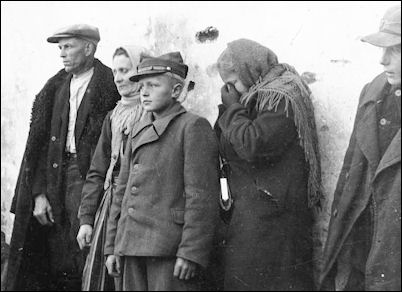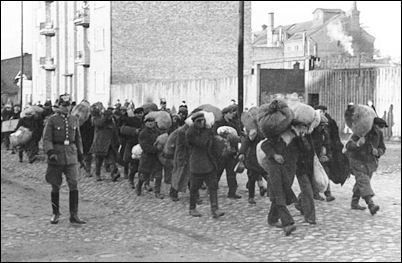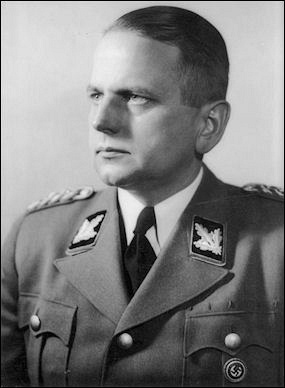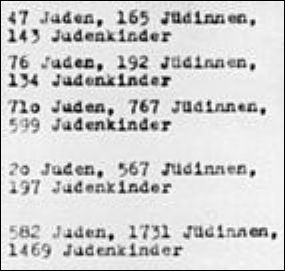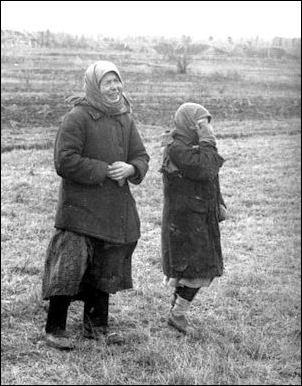
Mass Murder in the East
The quest for Lebensraum in the East was a carefully contemplated, step-by-step, process. First, the land was forcibly seized by Hitler's armies from its rightful inhabitants. Secondly, Heinrich Himmler's SS, with the knowledge and cooperation of the Wehrmacht, moved in to conduct special actions in accordance with the racial policies of the Führer. After this, Nazi political authorities moved in to administer and exploit the conquered lands in cooperation with the SS and Wehrmacht.
Poland was the first such conquest. Hitler loathed the neighboring country which had been set up by the victorious Allies at the end of the First World War. He ordered every facet of Polish culture and national identity obliterated and the people reduced to slave laborers.
Upon its conquest in September 1939, Himmler and his second-in-command, Reinhard Heydrich, quickly set up SS execution squads known as Einsatzgruppen to rid the population of all educated and prominent Poles. Trailing behind the Wehrmacht, the SS squads combed through cities and villages, shooting whomever they pleased, including Polish political leaders, land-owners, gentry, ex-army officers, business owners, professors, artists and intellectuals. Simply wearing eyeglasses was enough to get one shot, since it implied a person was educated.
Next, all higher education was abolished so the Poles would degenerate into a population of ignorant, obedient laborers. A memorandum Himmler wrote in May 1940 provided the details: “The non-German population of the eastern territories must not receive any education higher than that of an elementary school with four grades. The objective of this elementary school must simply be to teach simple arithmetic up to 500 at the most, how to write one’s name, and to teach that it is God’s commandment to be obedient to the Germans and to be honest, hard working, and well-behaved. I consider it unnecessary to teach reading.”
The model for Lebensraum, as outlined by Hitler, included large-scale resettlement of conquered territories by pure-blooded Germans at the expense of the people already living there. Over a million Poles were therefore forced out of their homes and farms which were confiscated along with shops, businesses, gold, artwork, raw materials, food and anything else of value – including children.
SS men were instructed by Himmler to keep an eye out for any blond-haired, blue-eyed children. When spotted, such children were kidnapped on the spot by the SS and sent off to Germany to be raised as Nazis. Parts of Poland had been settled by Germans in the past, and so Himmler wanted all 6 to 10-year-old Poles physically examined by Nazi racial specialists “to sort out those with valuable blood and those with worthless blood.” Those considered worthless were condemned to a life of slave labor under their German masters, or worse, if they happened to be Jewish.
Poland was also home to about three million Jews, the largest population of any country in Europe. Following its conquest, Hitler appointed an old comrade, Hans Frank, his longtime Nazi lawyer, to oversee the large southeastern portion of occupied Poland that was not annexed into the Reich. Much to the annoyance of Frank, Himmler used this area, known as the General Government, as the dumping ground for all of the unwanted Jews and Poles. As the number of Jews in the General Government continued to swell, Frank repeatedly expressed his dismay to Hitler and began advocating for some kind of alternative.
At this point, both Hitler and Himmler were still pondering a future "solution of the Jewish problem." In the meantime, as a temporary measure, Heydrich proposed rounding all up the Polish Jews in the General Government and placing them in SS-run ghettos at places such as Lodz, Cracow and Warsaw. Inside these walled-in ghettos, Heydrich explained, the Jews would be cut off from the outside world and squeezed into overcrowded areas where malnutrition and disease would naturally diminish their numbers.
Millions more Jews came under Nazi control as Hitler's armies swept across Russia beginning in June 1941. For Hitler and Himmler, the existence of so many of these unwanted people in the vast tracts of newly acquired Lebensraum was a pressing dilemma, requiring some thought.
Meanwhile, in compliance with Hitler's Commissar Order to liquidate all Russian political officials, Himmler unleashed his SS in Russia, creating four new Einsatz groups, totaling 3,000 men, which followed behind the German Army. At first, they only targeted Russian political officials, shooting them on sight. But SS field commanders soon enlarged the definition of a political official to include all Jewish men, in accordance with Hitler's belief that the Russian political system was the embodiment of Jewish-Bolshevism and therefore all Jews were implicated. The next step occurred in August 1941, when Himmler further expanded the task of the Einsatz units to include the shooting of Jewish families as well. This marked the beginning of a systematic, coordinated effort by the Nazis to murder all of the Jews in the East.
For the SS in Russia, the task ahead was huge. Throughout the vast countryside, there were hundreds of isolated little villages called shtetls populated exclusively by Jews. Into each village, truckloads of SS troops would arrive unannounced. The commanding SS officer would promptly summon the town’s leading citizens and inform them the entire population was to be immediately resettled. With no time to think, the men from the village were rushed into the trucks and taken off to a secluded site, followed a short time later by the women and children.
Otto Ohlendorf, an Einsatz group commander, explained what happened at the execution site: “They were ordered to hand over their valuables to the leader of the unit, and shortly before their execution to surrender their outer clothing. The men, women and children were led to a place of execution which in most cases was located next to a deeply excavated anti-tank ditch. Then they were shot, kneeling or standing, and the corpses thrown into the ditch.”
Einsatz leaders such as Ohlendorf kept a precise tally of executed Jews so the number could be reported back to Himmler. Soon a competition arose among the four Einsatz groups to see who could report the highest tally, and so they dashed from place to place in search of ever-more Jews.
As Hitler's armies plunged deeper into Russia, the massacres grew in size, culminating in late September 1941, when 33,771 Jews in the Ukraine were rounded up and killed over two days in the Babi Yar ravine outside Kiev.
One of the few survivors, Dina Pronicheva, recalled: "It was dark already...They lined us up on a ledge which was so small that we couldn't get much of a footing on it. They began shooting us. I shut my eyes, clenched my fists, tensed all my muscles and took a plunge down before the bullets hit me. It seemed I was flying forever. But I landed safely on the bodies. After a while, when the shooting stopped, I heard the Germans climbing into the ravine. They started finishing off all those who were not dead yet, those who were moaning, hiccupping, tossing, writhing in agony…They started covering the corpses over with earth. They must have put quite a lot over me because I felt I was beginning to suffocate…Then I decided it was better to be shot than buried alive. Using my left arm I managed to move a little way up. Then I took a deep breath, summoned up my waning strength and crawled out from under the cover of earth. It was dark…I was lucky enough to crawl up one of the high walls of the ravine, and straining every nerve and muscle, got out of it."
Curious about the whole process, Himmler ventured into Russia and watched an Einsatz squad execute a hundred Jews at Minsk. As the squad fired upon the first set of lined-up people, Himmler appeared on the verge of fainting. When a second set of Jews went before the same firing squad, the shots failed to kill two women, greatly upsetting Himmler, who cried out for the women to be put out of their misery. After this emotional experience, Himmler settled on the idea of trying gas as an alternative to firing squads, believing it would spare his SS men the ordeal of shooting women and children.
Newly developed gas trucks were then introduced for experimental usage. Each of these mobile vans contained an airtight rear compartment into which the engine’s exhaust fumes were fed to asphyxiate the 15 to 25 people inside while it was driven toward a mass grave. The vans, however, presented their own problems. The amount of time it took for people to perish from the carbon monoxide in the fumes varied widely causing some to arrive at the grave site still alive. Removal of the bodies from the rear of the van also became a gruesome sight for the SS men involved.
Although the vans were troublesome, the idea of gassing took hold. SS officials began experiments using air-tight chambers in concentration camps with exhaust fumes piped in from a diesel engine mounted just outside the chamber. Additional experiments involved the usage of a commercial pesticide called Zyklon-B, which gave off deadly cyanide fumes when exposed to air. While the gassing experiments were underway, mass shootings of Jews continued all over occupied Russia with a tally that soon surpassed 630,000 persons.
By November 1941, Hitler's armies had conquered most of western Russia and stood on the outskirts of Moscow. By this time, Soviet leader Josef Stalin had issued a decree for all-out guerrilla warfare behind the lines. Hitler reacted to this new development with glee, privately telling his Nazi overseers for the East: "The Russians have now given out the order for a partisan war behind our Front. This partisan war again has its advantage: it gives us the possibility of exterminating anything that opposes us."
Thus began a spiral of death in occupied Russia in which all semblances of civilized behavior and traditional military protocol vanished and human life itself had no value. For Germans behind the lines, revenge became the order of the day. Wherever anti-Nazi partisans attacked, the Wehrmacht and SS responded with astounding brutality, killing a hundred hostages for every dead German – sometimes picking a village at random and killing all of the inhabitants.
But over time, this only deepened the resolve and hatred of the entire population. In Russia, everywhere the Germans went they made instant enemies. All opportunities to win people over were squandered, despite the fact that some ethnic regions, such as the Ukraine longed for independence from Stalin and his oppressive Soviet regime. Although the German invaders were initially welcomed upon their arrival in the Ukraine and other independence-minded communities, they treated everyone in Russia as Slavic sub-humans. Erich Koch, Nazi administrator for the Ukraine, summed it up: "We are a master race, which must remember that the lowliest German worker is racially and biologically a thousand times more valuable than the population here."
Koch and fellow overseers in Russia also viewed the population as a limitless pool of slave labor. Regular roundups soon began in which civilians of all ages were packed into railroad box cars and shipped off to Germany to toil in mines, fields and factories.
Those left behind focused their wrath on all things German, requiring whole divisions to be pulled from the Eastern Front to restore order behind the lines at a time when every available soldier was needed elsewhere. Too late, an observant Nazi official in the East would note: "The Russian fights today with exceptional bravery and self-sacrifice for nothing more or less than recognition of his human dignity."
Nazi contempt for Russian civilians also applied to the millions of now-helpless prisoners of war. Although the Eastern Front had become static by the end of 1941, till then each day saw thousands more Russians added to the tally of prisoners. On the long marches to the rear, they were denied all food and water and were subsequently penned up in giant outdoor stockades, left to starve or perish from the winter weather. Ultimately, half of all Russian POWs, some three million men, would die in German captivity.
On the surface, Hitler remained confident about the war in Russia, anticipating victory sometime in 1942. But his failure to achieve victory by the autumn of 1941, as originally planned, had unforeseen consequences. A quick victory over the Russians would have allowed Hitler to confront the lonely British with a fate-accomplished in Europe, forcing them to humbly negotiate for peace, or so he had believed.
But by now, British Prime Minister Winston Churchill had squarely allied himself with Stalin and the Russians. Additionally, both the Russians and British were bolstered by their alliance with Hitler's newest enemy, the United States of America.
Copyright © 2010 The History Place™ All Rights Reserved
![]()
NEXT SECTION - America Enters the War
See also: The History Place - Holocaust Timeline
The Defeat of Hitler Index
The History Place Main Index Page
Terms of use: Private home/school non-commercial, non-Internet re-usage only is allowed of any text, graphics, photos, audio clips, other electronic files or materials from The History Place.
